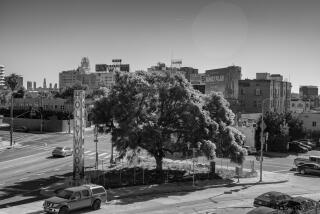A sturdy canopy, with a catch
- Share via
MAYBE you remember the first time some trusted adult handed you carob and said, “Here, try this. Tastes like chocolate.”
C’mon. Tastes like chocolate?
It’s unfortunate that carob carries such baggage, because the carob tree is one of the most ideal anchors for a Southern Californian landscape. It’s highly drought-tolerant, evergreen, food-bearing, unpopular with pests -- and it’s pretty. The carob tree is a big ball of shimmering dark green leaves, sitting atop a stout, romantically coiled trunk. It’s the tree of children’s drawings. It’s a tree for storytellers.
The branches are compact, irregular and twisty. The gray bark is draped like a smoky gown, and the flowing folds and burls create hand-sized cavities that seem to hide mysteries within. If Boo Radley had lived in Pacoima or Tujunga or Pasadena, he would have tucked his secret gifts to Scout into a carob tree.
But “To Kill a Mockingbird” takes place in Alabama, where carobs don’t do well. The trees don’t grow where it rains cats and dogs and sometimes frogs. Carobs don’t like it frosty either. They like our brand of weather.
Carobs are satisfied with 6 to 15 inches of rain per year, so even drought years like the one we’ve just endured are perfectly acceptable to the trees. They will do nicely in almost any soil as long as that soil drains well; although their root systems are comparatively deep, they cannot survive boggy conditions. Once established in the yard, new trees can be left alone and allowed to wait for their own water.
These slow growers will eventually reach 40 to 50 feet in height and width. The leaves are a bit oval and leathery to the touch. The glossy sheen reflects sunlight and heat away from the trees, an evolutionary trick that allows them to withstand desert temperatures. They’re a fine choice for shading a house, as long as you don’t mind sweeping.
As anyone who grows these trees will tell you, carobs yield a boatload of pods. In springtime, hundreds of 6-inch-long, pale-green pods tassel each tree. In late summer these pods ripen to a deep brown and begin raining to the ground. The whopping crop is a maintenance burden to some, a religious symbol to others.
St. John’s bread is the colloquial name given to the tree based on the belief that the locusts that fed John the Baptist were actually carob pods. Dried carob graces Jewish tables during the holiday Tu Bishvat. During Ramadan, Muslims serve drinks made with carob juice.
You may now audition for “Jeopardy!”
And you can stop looking for that anchor to the garden. Try the tree with the edible pods. Just don’t expect them to taste like chocolate.
--






